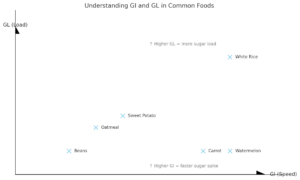For people living with diabetes, meal planning is about more than just avoiding sugar—it’s about understanding how different foods affect blood sugar levels. Two essential concepts that help with this are the Glycemic Index (GI) and the Glycemic Load (GL). By learning to use these tools, people with diabetes can make smarter dietary choices to maintain stable blood glucose levels.
1. What Is the Glycemic Index (GI)?
The Glycemic Index (GI) is a rating system that measures how quickly carbohydrates in food raise blood sugar levels. It compares foods to pure glucose, which has a GI of 100.
GI Categories:
-
Low GI: 55 or less
-
Medium GI: 56–69
-
High GI: 70 or more
Examples:
| High GI Foods (Fast spike) | Low GI Foods (Slow spike) |
|---|---|
| White rice, white bread | Brown rice, whole grain bread |
| Potatoes, corn | Sweet potatoes, beans |
| Sugar, breakfast cereal | Nuts, leafy greens |
| Processed snacks | Apples, berries |
2. What Is the Glycemic Load (GL)?
While GI tells us how fast food raises blood sugar, GL measures the overall impact by also considering the quantity of carbs eaten.
GL Formula:
GL = (GI × amount of carbohydrate in grams) ÷ 100
This means even if a food has a high GI, it may not spike your blood sugar much if it contains very little carbohydrate.
GL Categories:
-
Low GL: 10 or less
-
Medium GL: 11–19
-
High GL: 20 or more
Examples:
-
Carrots: GI 71, but GL only 6 → Safe in moderation
-
Watermelon: GI 72, GL 4–7 → Surprisingly OK in small amounts
➡️ Bottom line: Don’t judge a food solely by its GI—GL tells the full story.

3. How to Use GI & GL in Daily Life
Here are practical ways to apply these concepts to your everyday meals:
✅ Choose low-GI, low-GL carbs
-
Go for whole grains like brown rice, oats, barley
-
Limit or swap out white rice, white bread, and sugar
✅ Portion control is key
-
Even low-GI foods can cause blood sugar spikes in large portions
-
Keep rice to 2/3 cup per meal, and bulk up with vegetables and protein
✅ Combine with protein and healthy fats
-
Add protein (chicken, tofu, fish) or fats (avocado, olive oil) to slow glucose absorption
✅ Be mindful of cooking methods
-
Steaming or boiling is better than frying
-
Undercooked pasta (al dente) has a lower GI than soft-cooked pasta
-
Chew slowly and eat mindfully to further reduce glucose spikes
4. Real-Life Cases
📍 Case 1: A Woman in Her 50s Changes Her Breakfast
Before: 2 slices of white bread + strawberry jam → GI: 85+, GL: very high
After: Oatmeal + yogurt + blueberries + almonds → GI: ~45, GL: low
Result: Lower fasting glucose (from 109 to 96 mg/dL), more energy in the morning.
📍 Case 2: A Man in His 60s Adjusts Dinner
Before: Full bowl of white rice
After: ½ bowl of brown rice + grilled fish + steamed broccoli + tofu
Result: Post-meal blood glucose dropped from 170 mg/dL to 130 mg/dL.
📍 Case 3: A Busy Office Worker Navigates Dining Out
During a BBQ dinner:
-
Skipped soda, ate lettuce wraps with meat
-
Halved rice portion
-
Chose coffee over dessert
Result: Enjoyed the meal and kept blood sugar stable.
5. Clearing Up GI & GL Misconceptions
| Food | GI | GL | Common Misbelief | Reality |
|---|---|---|---|---|
| Carrots | 71 | 6 | Too sugary for diabetics | GL is low—safe in moderation |
| Watermelon | 72 | 5 | Should be avoided | OK in small servings |
| Bananas | 51 | 13 | Low GI = eat freely | Watch portion—GL is moderate |
6. Takeaway: Use GI & GL as Your Meal Compass
Think of GI and GL as your “blood sugar compass” to navigate food choices wisely.
✔ Quick Summary:
-
Understand both GI (how fast) and GL (how much impact)
-
Choose low-GI, low-GL foods
-
Combine carbs with protein/fat for balance
-
Pay attention to portion sizes and preparation methods
By applying these concepts, you can enjoy food without the fear of sudden blood sugar spikes—and take real control of your diabetes.